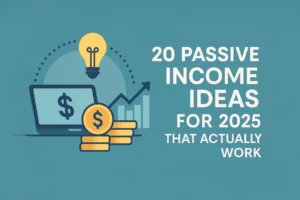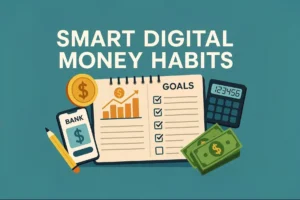Introduction: Why Micro Investing Works for Freelancers
Freelancers also have to deal with income uncertainty, irregular pay, and the constant pressure of having to look forward. That’s why more and more solo professionals are turning to micro investing apps for freelancers—apps that enable you to build wealth over time, even when you don’t have a regular paycheck coming in. These kinds of apps enable you to invest pocket change or cents regularly so that you can build long-term savings without disrupting cash flow.
In comparison to traditional investing sites with sky-high fees, micro investing apps are easy and friendly for beginners. They are especially convenient for gig workers, digital nomads, and remote employees who want to make more intelligent money choices without the frustration of tricky finances. With a few taps on your phone, you can set money saving automatically, which means small habits equal big rewards.
In this post, we’ll discuss the top micro investing apps for freelancers, their features, and show you precisely how you can utilize them to improve your freelance lifestyle. Whether you’re beginning from scratch or need to make the most of your earnings, this article will allow you to make financial decisions for 2025 and beyond confidently.
2. What Is Micro Investing and How Does It Work?
Micro investing is a simple method of building wealth by investing small sums of money—sometimes as low as a few dollars—into stocks, ETFs, or cryptocurrency. It’s ideal for freelancers with little in savings who want to start building long-term financial security. micro investing apps for freelancers these days make it easy.
These platforms enable you:
- Invest spare change by rounding up purchases
- Build small, recurring contributions
- Invest in fractional shares of stock
Popular options include Acorns, Stash, and Public, all making it easy to invest even when your earnings fluctuate from month to month.
Want to boost your savings too? Read our guide on freelancer money-saving tips and see how micro investing fits into your financial game plan.
3. Why Freelancers Should Consider Micro Investing
Freelancers too face irregular income, and it becomes hard to adhere to traditional investment schemes. This is where micro investing apps for freelancers are becoming the go-to wealth-creation instruments. The apps offer unprecedented flexibility, have minimal starting requirements, and generate long-term wealth—even when your income is not regular from one month to another.
Flexibility That Fits Freelance Life
Freelancers are not necessarily paid according to a fixed schedule. Micro investing applications understand this and allow you to invest only when you want to. You can pause, restart, or modify your contribution amount at any time. Investing becomes less stressful and easier even for lean months.
Low Entry Barriers
Unlike other traditional investing websites that require you to invest hundreds or even thousands of dollars as a starting investment, you can start micro investing with as low as $1. This makes wealth creation more accessible to more beginners or those who are still learning to have better control over their money. Micro investment apps like Acorns and Stash are popular for encouraging fractional share investing and small regular deposits that would fit into a freelance budget.
Long-Term Gains Without the Stress
Micro investing might be small, but those little amounts added up in the long term really do add up—especially if invested regularly. With compound interest and dividend reinvestment, your portfolio can increase with virtually no input on a daily basis. It’s an excellent way to accumulate passive wealth, in addition to freelance earnings.
If you’re also interested in automated ways of increasing your income, check out our tutorial on how to start an AI-powered online business with minimal risk and upfront investment.
At the end of the day, micro investment apps for freelancers offer a realistic, low-risk, and painless way to start investing—without requiring you to have deep pockets or a PhD. If you’re serious about building your wealth, starting small is much better than not starting at all.
4. Key Features to Look for in Micro Investing Apps
Not all micro investing apps for freelancers are created equal. While most have low barriers to use, the functionality they offer can make a big difference in how easy and effective your investing will be. The following are the essentials freelancers need to consider when choosing the best platform.
Automatic Investing Options
Freelancers work for clients, issue invoices, and deliver on time; the last thing you want is to waste time manually putting in every time you receive payment. Locate apps with automatic round-ups, scheduled deposits, or percentage contributions from your earnings. Apps like Acorns excel in this, making you accrue wealth without additional time.
Low Fees and No Hidden Charges
When you invest small amounts, high fees can eat through your profits fast. Go for apps with transparent fee structures and low monthly fees. Most of the best-rated apps offer beginner-friendly plans that cost less than $5 a month. This will let you build over time without losing gains.
Fractional Share Investing
This feature allows you to invest in popular companies like Apple, Tesla, or Amazon without necessarily buying a full share. Fractional investing is best suited for freelancers who have tighter budgets. Public and Stash are the applications which are well known to favor this model.
Educational Resources for Beginners
Whether you’re a beginning investor or just need the reminder, a great app will give you simple lessons, videos, or blog posts to guide your investment journey. Websites that will teach you to diversify or make logical decisions and not emotional ones are pure gold—if you’re learning as you earn.
Tax-Advantaged Accounts
Some apps allow you to invest through retirement or tax-deferred accounts like Roth IRAs or SEP IRAs. If you’re a freelancer with irregular income, it’s worth having access to these as a way to maximize your long-term tax efficiency. It is also recommended that you consult with a financial advisor or CPA, especially if you’re using multiple income tools or earning side income. You can also find hidden features in popular apps that can assist with this.
Mobile Experience and Ease of Use
Since freelancers spend most of their lives on the move, having a well-designed app with an intuitive interface is essential. You should be able to view your portfolio, edit contributions, and access resources directly from your phone without going through much hassle. Look at user reviews and ratings before you sign up to any platform.
Security and Transparency
Security must always be a primary issue. Ensure the app employs encryption, two-factor authentication, and an open privacy policy. Steer clear of platforms with limited data or unknown terms. An open app earns long-term trust from its users and safeguards your financial information.
If you’re still building your freelance career, don’t forget to check out our guide on how to start freelancing. Pairing smart income strategies with micro investing can multiply your results over time.
Choosing the right features in micro investing apps for freelancers can turn small habits into real financial progress. The key is finding a tool that works with your lifestyle, not against it.
5. Top Micro Investing Apps for Freelancers in 2025
There are hundreds of sites available these days, yet not all micro investing apps for freelancers are designed for flexibility, automation, and learning. The following are the top picks for 2025 based on features, usability, and how well they suit freelancers building wealth with limited time and money.
Best Overall App for Freelancers: Acorns
Acorns is the best overall option for freelancers in 2025. It automatically rounds up purchases and invests the remaining change, which is ideal for passive investing. You can also set recurring contributions, establish a retirement account, and receive basic money education resources all in one app.
Acorns is perfect for freelancers who are already using digital tools to grow their income.
Best for Automated Investing: M1 Finance
M1 Finance has strong automation features. Once you’ve created your “pie” (a pie is a customized investment portfolio you can build), M1 will automatically rebalance your investments and invest them in line with your chosen allocations. It’s a good choice for freelancers who want maximum control without having to do it manually.
Its zero-commission approach and robo-advising and self-directed hybrid make it a smart choice for long-term wealth builders.
Best for Beginners: Stash
Stash is also among the most beginner-friendly platforms. It offers curated investment options, simplified language, and has users start with just $5. Stash also includes banking features and a rewards-earning debit card and allows freelancers to make spending and investing simpler on one platform.
New to finances and freelancing? Read our article about how to start freelancing for tips on building your income as well as good financial practices like micro investing.
Best for Crypto Exposure: Robinhood
Robinhood offers commission-free stock trading, but it’s also the easiest way to get exposed to cryptocurrency such as Bitcoin and Ethereum. For freelancers who want to diversify beyond traditional assets, Robinhood offers crypto, stocks, and ETFs in one mobile app.
It doesn’t offer bells and whistles like round-ups or auto-invest, but it’s great for freelancers that want to build and track individual traditional and digital asset portfolios.
Best with Education Resources: Public
Public combines micro investing with education and community. You can follow proven investors, read vetted news, and ask questions directly on the platform through Public. Public also offers transparent prices and fractional shares, so it’s a worthwhile resource for freelancers who’d like to learn in tandem with their investment.
If you’re into platforms that help uncover extra value, you’ll enjoy our article on hidden money-making app features freelancers often overlook.
Each of these micro investing apps for freelancers brings something different to the table. Whether you’re looking for automation, education, crypto access, or hands-off growth, there’s a perfect match to fit your financial goals in 2025.
6. How to Get Started with Micro Investing as a Freelancer
Beginning micro investing apps as a freelancer requires no finance degree or investment of thousands of dollars. One can begin with some dollars and a willingness to build good habits. Below is a simple step-by-step process on how one can confidently start investing as a freelancer.
Step 1: Choose the Appropriate Micro Investing App
Select an app that aligns with your objectives and workflow. If you like full automation, Acorns is the one to use. For even greater control and exposure to crypto, Robinhood might be the better choice. Look at our in-depth list in Section 5 to compare leading players based on features like automation, learning, and fractional investing.
Step 2: Set a Realistic Budget
Freelancers typically have variable income, so the trick is to begin small. Even $5 to $10 a week can be long-term. Choose a figure that won’t affect your capacity to pay bills and other expenses.
Step 3: Automate Your Contributions
Next, utilize the app’s automation features to invest on a regular basis. Most apps allow you to invest daily, weekly, or when you receive pay. Automating regular investments helps ensure that you do it on a consistent basis, which is important for long-term growth.
Step 4: Diversify Your Investments
Don’t concentrate everything in one company or sector. Use ETFs or pre-assembled portfolios that have a diverse mix of stocks, bonds, or even cryptocurrency if the platform accommodates it. Platforms like M1 Finance allow you to build a customized investment “pie” with diversified assets.
Step 5: Track Progress and Learn Along the Way
Most apps give insights and learning tools. Use them to understand your portfolio’s performance and refine your strategy with the passage of time. If you’re in the mood for more general strategies to earn money online as well, learn how to start an AI-based business which would fund your investments.
Step 6: Avoid Common Mistakes
Don’t panic sell when the market goes down, and don’t risk money that you don’t want to lose. And don’t overpay in fees. Our next Section 7 goes further into what to avoid.
Bonus Tip: Create Around Your Freelance Workflow
Link your investing activity to milestones like paying clients or completing projects. For example, invest a portion of every invoice you send out. This creates a habit loop around your freelance income.
Micro investing is especially useful for freelancers who wish to build wealth while managing unpredictable income. For more tips on time savings, see our post on how to manage multiple clients efficiently.
By merely doing these steps, you can start using micro investing apps for freelancers and grow your wealth less stressed and more planned.
7. Mistakes to Avoid When Using Micro Investing Apps
Micro investing apps for freelancers have made it easier than ever to begin building wealth with just a few dollars. But with ease comes a tendency to overlook some key pitfalls. These platforms may be beginner-friendly, but using them incorrectly can lead to slow growth, frustration, and even financial losses. Whether you’re new to investing or already dabbling in the markets, here are the most common mistakes freelancers make and how to avoid them.
Ignoring Account Fees and Hidden Charges
Affordable access to the stock market is one of the best things about micro investing apps for freelancers. Not all apps are created the same, however. Some apps charge subscription fees, inactivity fees, or transaction fees that will eat into your profits—especially if you are investing small amounts. For example, as much as apps like SoFi Invest offer free trading, others will require you to pay monthly fees for premium features. Make sure to read the fine print before signing up.
Overtrading Based on Emotions
Freelancers are accustomed to dealing with unpredictable income and financial anxiety, which can lead to impulsive decisions. Perhaps the most common mistake is panic-selling investments in a declining market or trying to make quick gains by excessively buying and selling assets. Excessive trading not only increases expenses but also takes away from long-term growth. Micro investing is best done patiently and regularly. Make a plan, set up your payments, and do not check your portfolio every day if not necessary.
Poor Diversification
Diversification is necessary to reduce risk, especially with small investments. Most freelancers invest all their investments in a single stock, sector, or asset class like crypto. This is dangerous if that asset loses value. Most popular micro investing apps for freelancers, i.e., Acorns or Stash, offer exposure to diversified ETFs, bond portfolios, and fractional shares of blue-chip stocks. Diversify across asset classes and sectors to form a solid foundation.
Investing Without a Goal
It’s easy to simply dive in and start investing willy-nilly with no goal in mind. But micro investing does best when it has a goal. Are you investing for retirement, a rainy day, or passive income in the long term? Having a purpose will determine your risk tolerance, your time frame, and which app or investment product is best for you. If, for example, your goal is retirement, you’ll likely want a platform that offers IRAs like Fidelity Go.
Getting Sucked into Hype or Get-Rich-Quick Schemes
Freelancers often turn to investing to make more money, but beware of sites that promise astronomically high returns. Some apps may promote meme stocks, new crypto tokens, or dangerous strategies disguised as easy money. Always research investment products. Stay on regulated platforms, and never put your hard-earned freelance funds into assets you don’t understand.
Not Rebalancing or Adjusting
Your financial goals and market conditions change over time, and your portfolio should too. Rebalancing involves reviewing and adjusting your asset mix to stay aligned with your risk tolerance. If one type of investment grows significantly, it may dominate your portfolio and increase your exposure to risk. Some apps automate this process, but not all. Be sure to review your investments quarterly and rebalance when needed.
Not Monitoring or Learning from Performance
Set-and-forget is okay to a point, but total obliviousness to your investment activity is risky. A lot of freelancers overlook this step. Use your app’s built-in performance tracking tools to check your returns and note trends. Understanding why your portfolio went up or down makes you make smarter decisions down the road. If you notice you’re facing consecutive losses or leveling off, it may be time to readjust your strategy or switch platforms.
Choosing the Wrong App for Your Situation
Freelance micro investing apps are not made alike. Some are good at automation, others at educational tools, and others at cryptocurrency access. Choosing an app that does not align with your financial style or your situation can set you back. If you want hands-off control, for instance, an app like Acorns that automates everything would be ideal. If you like more control, Stash or Public might suit you better. Match the tool with your goal and personality.
By avoiding these beginner mistakes, freelancers can maximize the benefits of micro investing and lay a strong foundation for long-term success. With the right mindset, consistency, and app selection, micro investing can prove to be one of the smartest financial choices you ever make.
8. Success Stories: How Freelancers Are Growing Wealth with Micro Investing
Many freelancers are proving that you do not need a huge salary to build lasting wealth. With the help of micro investing apps for freelancers, real users have turned small, automated deposits into meaningful savings and investments. Below are success stories from actual freelance professionals who used platforms like Acorns and Stash to grow their portfolios with discipline and consistency.
✅ Real Story: $1,800 Saved in Just 8 Months Using Acorns
One freelancer shared their success story on Reddit after using Acorns:
“I managed to save $1,800 in 8 months… I opened my Acorns account, started with $25 monthly, and activated 1× round-ups. That helped me save about $100–130 each month. Eventually, I increased my deposit to $50/month and raised the round-up multiplier.”
Key takeaway: This freelancer combined automated contributions and round-ups to grow their savings in the background without stress or disruption to their freelance work.
🚀 Freelancer Grows Portfolio 40 Percent with Small Contributions
Another micro investor on Reddit, also a freelancer, shared how they used automation to scale their portfolio:
“I’m currently up 40 percent. I make about $500/month and invest using 10× round-up settings. It really adds up. I’ve been happy with the returns so far.”
This story shows that even with modest income levels, micro investing apps for freelancers can make a significant financial difference. Small amounts, invested consistently, can lead to impressive growth.
🌱 What Freelancers Can Learn from These Stories
- ✔️ Start small and stay consistent: Even $5–$10 weekly can build long-term wealth.
- ✔️ Let automation do the heavy lifting: Round-up features and recurring deposits save time and effort.
- ✔️ Use returns to reinvest: Compounding works best over time, so staying in the game matters.
Conclusion: Turning Spare Change into Real Wealth
Micro investing apps for freelancers are more than trendy programs. They represent a new method for independent contractors to build permanent financial security. With non-conforming income and changing workloads, freelancers often struggle to place investing high on the list. But with these programs, loose change can be turned into diversified portfolios, even without great financial savvy.
Micro investing is achieved by being consistent, wise app selection, and cutting costly mistakes like overtrading or lack of diversification. You’re saving for retirement, building an emergency savings fund, or just want to grow your income beyond client reimbursements, micro investing gives you the control and flexibility to keep going.
Freelancers’ micro investing apps are no silver bullet, but if employed purposefully, they are a strong beginning towards building actual wealth. Start in bite-sized pieces, be relentless, and use the resources offered to cement your financial future—one investment at a time.
Ready for what’s next? These fresh posts are packed with value:
- AI Tools for Client Feedback: Work Smarter in 2025. It shows you how to use AI to collect, analyze, and act on client feedback faster — without the manual back-and-forth.
- Digital Declutter for Freelancers: Reset Your Focus in 2025. Reset your work environment, mindset, and tools to cut distractions at the source
- How to Build a Personal AI Assistant in 2025 (No Coding) — streamline your workflow with your own custom AI helper.
- Freelancer Client Red Flags: 10 Signs to Avoid in 2025 — learn how to spot problem clients before they waste your time.
- 20 Passive Income Ideas for 2025 That Actually Work — diversify your income and earn while you sleep





